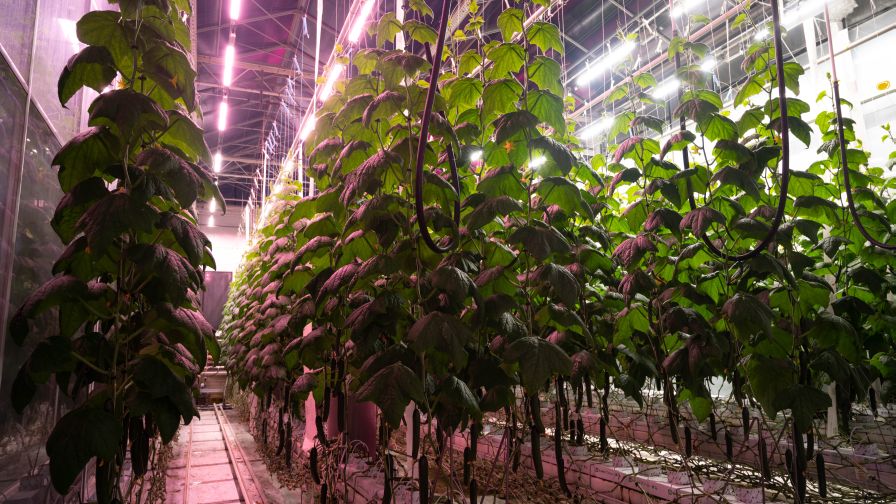A Cost-Effective Way to Make the Switch to LEDs in the Greenhouse

Photo: Fluence
Cannabis and food cultivators in California are facing an uncertain future as the California Public Utilities Commission and other state regulators search for ways to prevent another summer of rolling blackouts and power shortages. More than that, the state hopes to generate enough supply to maintain a 22.5% buffer that would provide a greater margin for error to account not only for peak demand, but for inevitable sustained heat waves and wildfires that will place additional stress on the grid.
It’s still years away from achieving that goal. According to Scientific American, the power supply shortage in California over the next five years will range from 600 megawatts to 3,500 megawatts, prompting regulators to experiment with new, more direct incentive and rebate programs that reward residents and enterprises for decreasing energy consumption during peak demand — most crucially the evening hours of summer months.
Those efforts culminated in the Market Access Program following Gov. Gavin Newsom’s July 2021, emergency proclamation to state energy regulators. Enacted through 2023, the program allocates $150 million to pay customers directly for decreasing energy usage during peak and non-peak demand hours. If payments are commensurate with average commercial value per kilowatt-hour, they could be 10 times greater than those for energy saved during non-peak hours.
The program deviates from more traditional rebate and incentive programs in a few ways. Payments are allocated based on trackable energy savings at the meter when compared to year-over-year consumption, while also giving energy aggregators more flexibility to design tailored energy savings plans for each customer’s technology portfolio, energy needs, and buying power without being forced to follow prescriptive or more rigid energy consumption and savings programs.
For California’s produce and cannabis cultivators, it presents the best chance they’ll have at investing in operational, technological, and performance upgrades to their facilities. But the $150 million granted under the program is first come, first serve, so capitalizing on that chance has to happen fast.
How the Program Impacts Commercial Cultivators
The Market Access Program represents perhaps the best opportunity for those still using legacy lighting systems to retrofit their facilities with more energy-efficient LEDs and other hardware despite the long-standing barrier to entry of upfront capital costs. For those who have already implemented LEDs in their greenhouses, it’s an opportunity to receive direct payments for using the most energy-efficient fixtures on the market, while incentivizing investments in other improvements like their HVACD systems.
While the cost of LEDs has dropped dramatically in recent years, it still requires investment not just in the fixtures themselves, but in optimizing a controlled environment under new lighting conditions. That can mean adjusting HVACD loads, altering vents, pipes, and wires, establishing more nuanced environmental controls, and identifying the right lighting strategy that achieves greater yields, higher profits, and a true return on investment in a retrofit.
Rebates and energy savings have long been major value propositions on which LED providers lean heavily: “Buy our LEDs, receive incentives, and let the energy savings flow.” Under the Market Access Program, that proposition becomes even more valuable because of the direct payments it offers. Many horticulture lighting providers are pushing hard on California’s growers to finally make the shift to LEDs — using the Market Access Program as the latest selling point. Others, like Fluence, are working with growers in the state to get even more creative through custom, extended payment structures that substantially decrease the upfront capital costs of a retrofit or facility upgrade for which the grower might otherwise be responsible.
But for many cultivators — especially in the state’s hypercompetitive, oversaturated cannabis industry that has seen prices drop as much as 50% in the last year — the promise of future savings months or even years down the road isn’t enough to justify the capital expense.
Cultivators need immediate relief — and new pathways to profitability — on a multitude of fronts. The state took its first step late last month by eliminating its grower tax, providing $40 million in tax credits for storefront retailers, microbusinesses, and cannabis equity operators, and capping the excise tax at 15% for three years, amid other provisions to reduce the stress on the legal cannabis market.
LED providers and others delivering critical services and hardware to California’s growers have to be just as flexible to create a more energy-efficient future for the state and new avenues for its growers to invest in facility upgrades that capture more savings and revenue.
The easiest route to do both is for providers to reinvent how they structure payments for their products. Rather than demanding up-front payments with the promise of reimbursements down the line, the Market Access Program gives LED providers like Fluence a unique opportunity to encourage investment in retrofits. Heavily reducing initial capital costs and implementing extended payments gives growers the opportunity to realize immediate energy and operational savings, receive direct payments for those savings through the Market Access Program, and improve crop and operational performance at the same time.
Such a model benefits both food producers and cannabis growers and represents the best opportunity growers have had — and likely will have for the foreseeable future — to reduce barriers to entry for newer and more efficient technologies.









